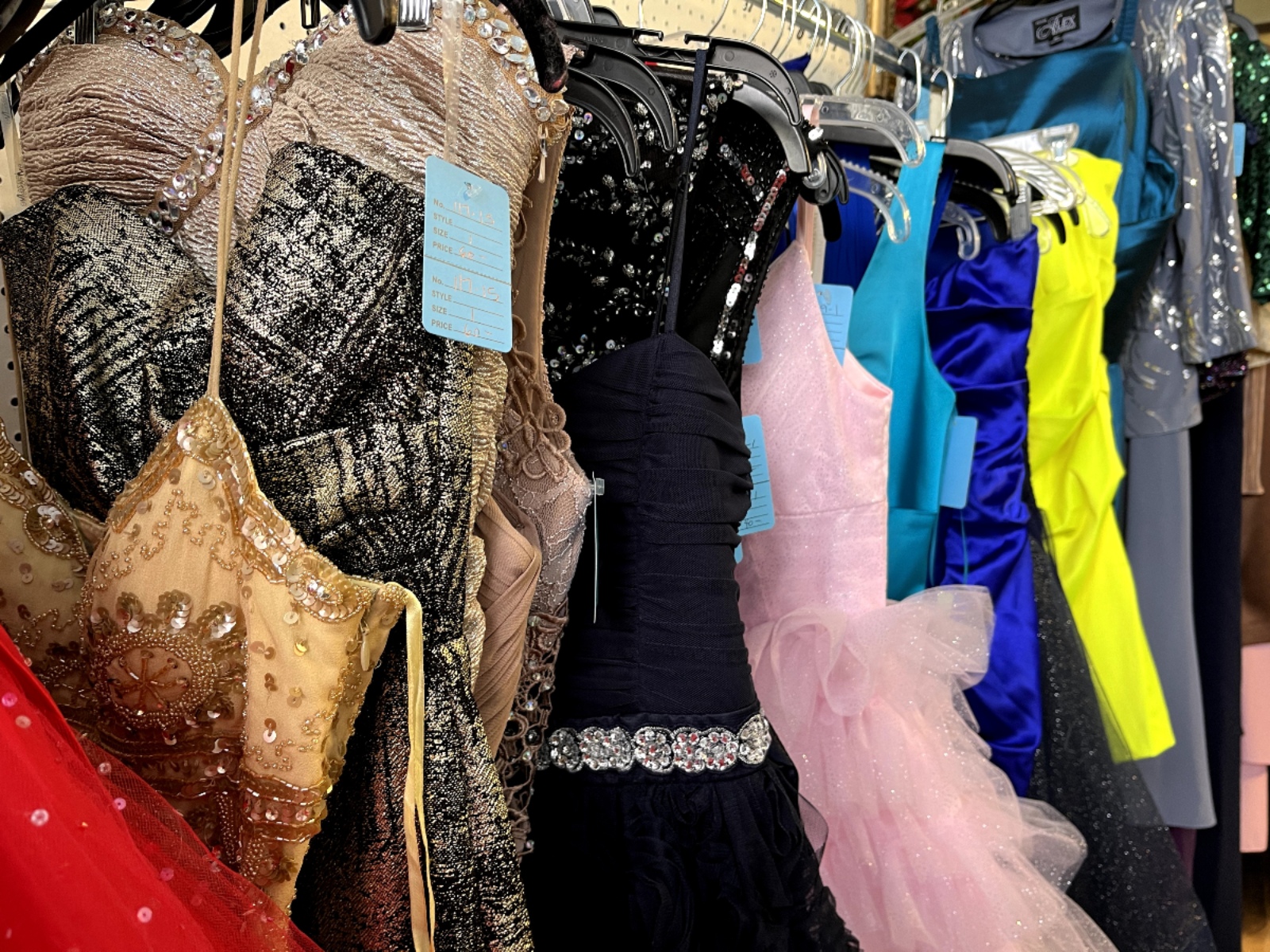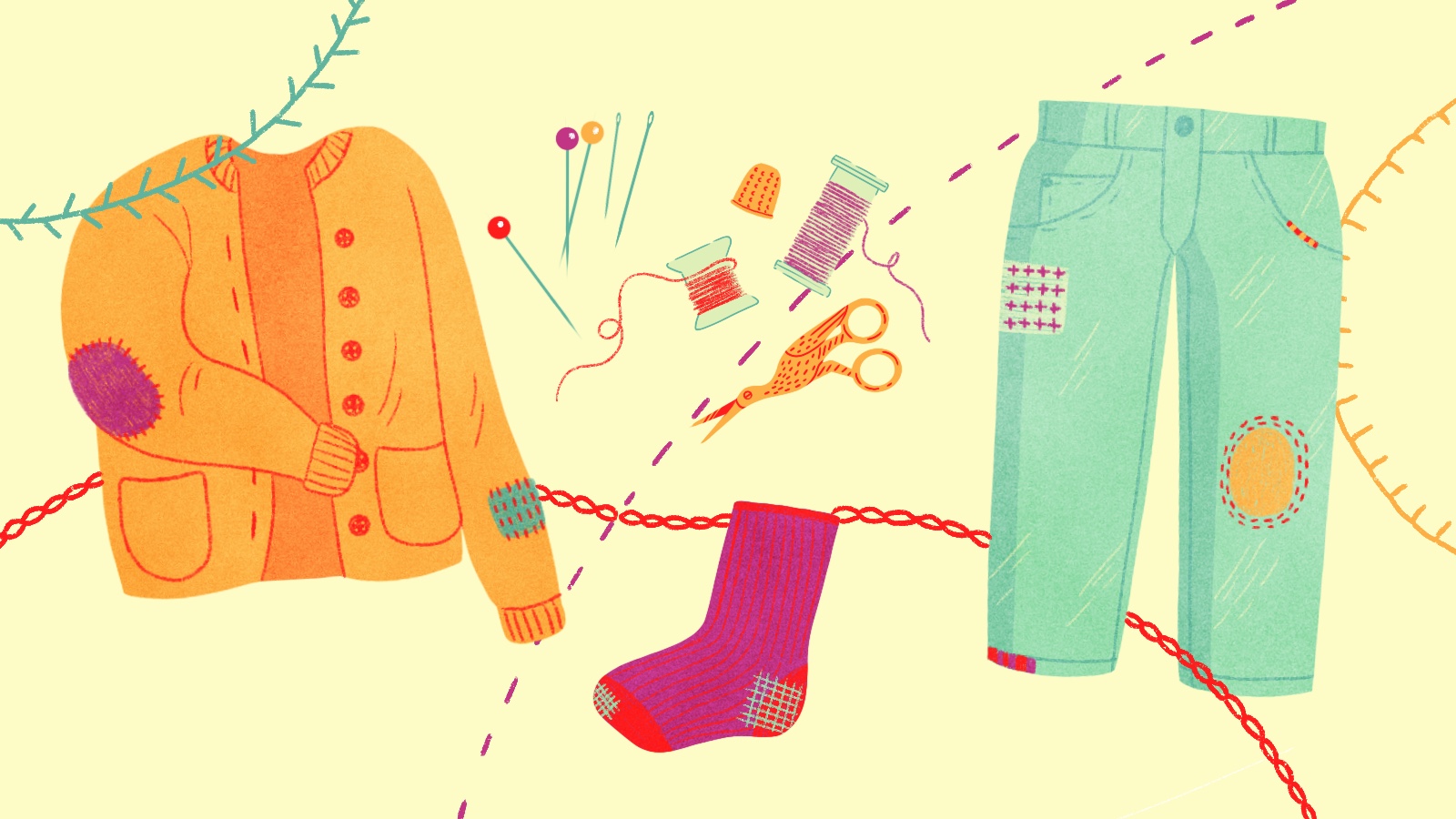This coverage is made possible through a partnership with Grist and Interlochen Public Radio in Northern Michigan.
On a Saturday in February, high school senior Kaylee Lemmien sifted through racks of dresses at Tinker Tailor, a small shop in downtown Elk Rapids, a village of about 1,500 people in northern Michigan.
“I’d call this a mermaid, sequin, light blue gown with a tulle skirt. It’s got a lace-up back, kind of open,” Lemmien said. “Very pretty.”
Tinker Tailor usually alters clothes, but on this day it was selling them — prom dresses, to be exact. Gowns in a variety of shapes, sizes, and colors — short and long, neons and pastels, satin and sequins — lined the racks. The garments were donated and consigned by people around the region, with the goal of giving them a new life at the Elk Rapids High School prom in May. Called Sustainable Style, the secondhand shopping initiative takes aim at fast fashion.
Zoe Macaluso, the president of the Eco Club at Elk Rapids High School, said that when a local volunteer group approached her with the idea, she “immediately latched onto it.” The Eco Club wants to use the project to lead by example and hopefully inspire other schools in the area to pursue their own climate projects.

It’s one of many efforts by high school students around the country to address fast fashion — clothing produced cheaply and quickly enough to stay on top of swiftly moving trend cycles — in their own lives and through advocacy. Such efforts are small, but experts say they can help people — especially young people — think differently about their role as consumers. That’s especially relevant in the age of fast fashion, when an online retailer like Shein drops up to 10,000 new items a day.
“Fast fashion is a trend driven by newness,” said Shipra Gupta, an associate professor of marketing at the University of Illinois Springfield. “It tends to treat its products like food that spoils quickly.”
The increased focus on sustainability and thrifting might seem counter to the rise of fast fashion. It’s been described as a paradox, especially for Gen Z. A McKinsey newsletter last year laid out the relationship like this: “On one hand, Gen Zers express a desire for sustainably produced items and love thrifting. On the other hand, clothing ‘hauls’ … make up some of the most watched and most produced content on social media.”
One way high school students are counteracting that offline is by raising awareness in their communities about how fashion impacts the environment. Last year, for example, a high school in New York put on a carbon-neutral prom. A club in New Hampshire organized a clothing drive to divert used clothes to people experiencing homelessness. And a library in Athens, Georgia, regularly hosts a “Bling Your Prom” secondhand formal wear event with an eye toward sustainability.
Fast fashion encourages people to cycle through clothing quickly, with serious consequences. But getting reliable information on just how much damage the fashion industry inflicts on the climate is difficult. Its lack of transparency is one reason for that; less than half of brands track all levels of their complex supply chains. Some have made climate pledges but have consistently fallen short of their goals. And while key legislation that would help tackle the problem is pending in places in the U.S. and Europe, policy progress has been slow.
Constantly being exposed to new items can trigger a desire to buy more, said Gupta. By bringing an event like Sustainable Style to the community, she said, the students in Michigan are harnessing that excitement and channeling it toward more environmentally conscious shopping.
“Community involvement is a way of doing that grassroots-level movement, where we can actually create an awareness among the community members,” she said, and that can make them consider what it means to be a responsible consumer.
Events like Sustainable Style can cut back on consumption locally, providing a responsible place to donate and buy used evening wear. That’s important especially in small towns where options can be limited.
In the past, students in Elk Rapids usually ordered dresses online or traveled to hubs like Grand Rapids, a two-hour drive south.
“You kind of have to drive to Grand Rapids, and you have to go to a mall, and you have to buy a new dress,” said Macaluso. “This just provides another option, another opportunity to say, ‘Oh, I have a chance here to help the environment a little bit. So I’m going to take it.’”
Perhaps most importantly, initiatives like these can help others outside the confines of high school prom think about how fashion relates to the environment.
“I think it’s very meaningful, because it starts to engage consumers, especially the young generation,” said Sheng Lu, an associate professor of fashion and apparel studies at the University of Delaware.
Innovative grassroots efforts have helped cut down on fashion waste locally in other places, and in recent years, major brands have been trying to work out the kinks of reselling used clothes.
Although the Elk Rapids effort is relatively small, Lu said, it can help inspire local action.
“I honestly was pretty nervous coming in here,” said sophomore Addison Looney, who was shopping with her mom. “But there were a lot of great selections. … I was pretty indecisive about it. But I picked [one] out.”
The dress is a soft lavender with beading in the front. Addison’s mom, Sara, said she was excited to buy her daughter a secondhand dress.
“Knowing this is just a great opportunity to shop local, and to obviously save money,” she said. “But also just the resale aspect of it — to just kind of keep dresses going, because they’re usually a one-time use.”
Macaluso said they’ve been able to stoke interest in buying used clothing. The prom event even led Tinker Tailor — which had mainly been in the business of altering clothes, not selling them — to set up a “Dress Vault” in the store so people could continue consigning, donating, and shopping for secondhand items.
“I think it really just builds off that idea of, ‘Hey, these dresses didn’t go bad, they haven’t expired,’” she said. “And they can find a new home.”





